Partial shadowing of photovoltaic modules affects the output characteristics of the module
1.0 Introduction
It is well known that factors such as surface shading, poor soldering, and unmatched cell power of crystalline silicon solar cells are the main causes of the reduction in output power. The influence of these factors is not only instructive in the manufacture of crystalline silicon solar cell modules, but also It is helpful for people to correctly judge the cause of the decrease or failure of the PV system output.
It has been reported abroad that some components used in the field for 10 to 15 years have deteriorated electrical characteristics. Its IV characteristic curve has been very different from some common photovoltaic modules, and this changed IV curve can be used to analyze the reason for the decrease of the output of the crystalline silicon solar cell module. This article mainly discusses the effect of shielding some of the output characteristics of the battery module, and uses a computer to simulate the nuclear process.
2.0 simulation method
In a crystalline silicon solar module, when a battery is blocked, the output characteristics of the module can be expressed by the following formula:

These parameter estimates can be replaced by some parameters: n=1.96, I0=3.86X10-5(A), Rsh=15.29(Ω). a=2.0x10-3, Vbr=-21.29 (V), nn=3. R3=0.008.
The circuit in which the battery is covered in the assembly can be represented by the picture 3. The normal battery and the covered battery are connected in series in the assembly, so the voltage V and the current I satisfy the following equation:
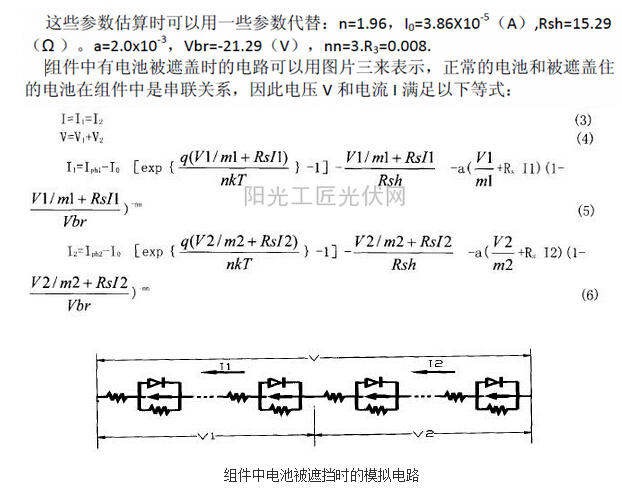
Among them, Iph1 represents the photocurrent of the ordinary battery in the assembly, Iph2 represents the photocurrent generated by shielding the battery and is related to the shielding transmittance in equation (2). For example, when the blocking transmittance is 35%, Iph2 is 0.35 times of Iph1. The characteristics of IV can be calculated by solving equations (3)-(6).
Second, the experiment
Figures 2(a) and (b) are calculated and actually measured IV characteristic curves by changing the shadow transmittance. When a battery on a component has a different transmittance (one component consists of 36 cells), the short-circuit current does not change substantially. As a result, the lower the transmittance, the faster the current drops with increasing voltage. On the other hand, the open circuit voltage is basically the same. It can be seen from the figure that the measurement results are consistent with the calculated results.
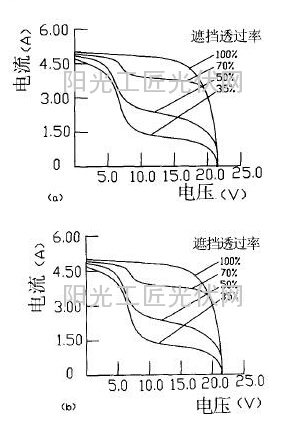
Fig. 2 shows the results of the calculation of the IV characteristic curve (number of blocked cells: 1) (a) of the blockage transmittance index, and (b) the measurement result.
Figure 3 (a) and (b) calculate and measure IV characteristics by changing the number of shaded cells (shadow transmittance is 35%). With the increase in the number of battery shields, the short circuit current becomes significantly lower, but the open circuit voltage change is not large. It can be seen from the figure that the measurement is consistent with the calculated results.
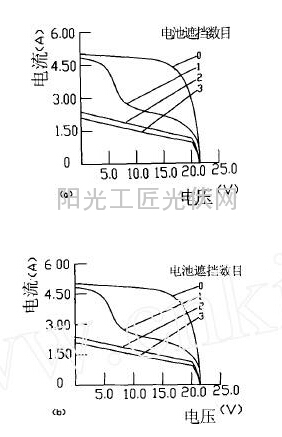
Fig. 3 shows the IV characteristic curve (obstructed transmittance: 35%) with the number of cells as a variable, (a) calculation result, and (b) measurement result.
Figure 4 shows test IV characteristics at different irradiances. One of the batteries was covered with shadows and the shadow's transmittance was 35%. As the irradiance increases, the current drop proportion increases near the short-circuit current. Figure 5 shows the IV characteristics tested at different irradiances. There are 3 cells shaded on one component (shadow transmittance is 35%). In this case, the current drop is small in the vicinity of the short-circuit current.
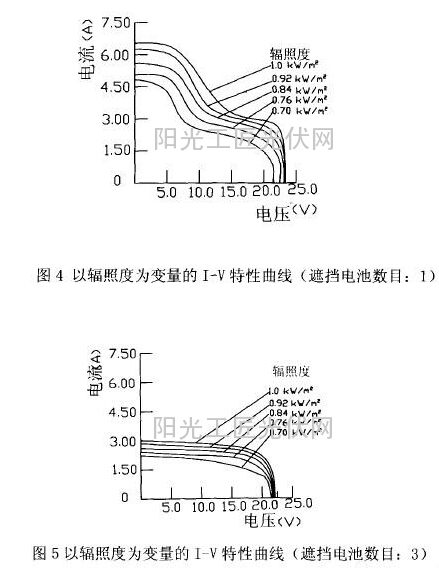
FIG. 6 is an IV characteristic curve measured by changing the position where the component is shielded at the same irradiance with an occult transmission rate of 35%. The number of occlusion is 3 (a module has 36 batteries). From the IV graph, it can be seen that although the occluded area is the same, the IV curves of the different locations are different, but the open circuit voltages are all equal.
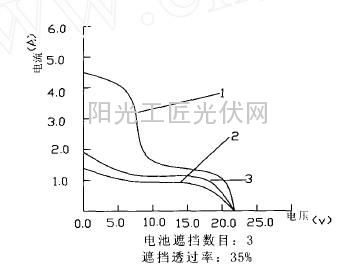
Figure 6 IV curves measured with different positions (curve 1 is a block of three consecutive cells; curve 2 is a continuous block of two blocked cells and a spaced apart cell; curve 3 is a block of three separate cells)
Third, the conclusion
In this paper, the relationship between the power output of the module and the change of the IV characteristic caused by the blockage of the battery was studied using a computer simulation and a component tester. The change in the IV characteristic when the component was occluded was related to the voltage drop of the covered battery.
The output IV characteristic curve of the crystalline silicon solar cell module is related to factors such as cell surface shading, poor soldering, and unmatched cell power, and the influence of different factors on the output power is different. The influence of these factors is studied not only on manufacturing crystalline silicon solar The battery assembly is guided by, and it is also helpful for people to correctly judge the cause of the decrease or failure of the PV system output. (The author WeChat public account: Photovoltaic experience network)
Flashlights,Led Aluminium Alloy Flashlight, Bright T6 Led Torch,Bright Led Torch
NINGBO ZHENGUO INTELLINGENT LIGHTING CO.,LTD , https://www.zguolight.com